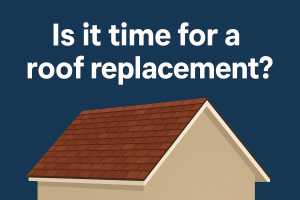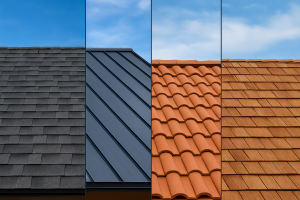When facility managers or property owners notice leaks, ponding water, or heat buildup inside a commercial building, one big question always comes up:
Should I replace my entire roof — or would a roof coating be enough?
That question has become one of the most searched topics in commercial roofing today. Rising material costs, supply delays, and sustainability goals have made roof restoration more attractive than ever. But it’s not a one-size-fits-all solution — the answer depends on your building’s roof type, condition, and long-term goals.
Let’s break down when a roof coating is the smarter move — and when a full roof replacement makes more sense.
Why Roof Coatings Are Trending in Commercial Roofing
Over the past few years, the commercial construction industry has seen a major shift toward sustainable and budget-conscious solutions. According to the National Roofing Contractors Association (NRCA), reflective and elastomeric coatings have grown more than 25% in use across commercial facilities since 2021.
That growth is driven by three key factors:
-
Cost savings – Coatings typically cost 40–60% less than a full roof replacement.
-
Energy efficiency – White, reflective coatings can reduce rooftop surface temperatures by up to 50°F, lowering HVAC load and extending equipment life.
-
Sustainability – Instead of sending tons of torn-off material to landfills, coatings allow you to restore what you already have.
What Exactly Is a Roof Coating?
A roof coating is a liquid-applied membrane that cures into a seamless, waterproof barrier over your existing roof. It’s engineered to protect commercial roofs made of materials like TPO, PVC, EPDM rubber, modified bitumen, built-up roofing, and metal roofs.
When properly installed, a roof coating creates a flexible, UV-resistant layer that expands and contracts with temperature changes. That flexibility helps prevent leaks, blisters, and premature cracking — common issues in large commercial roofs exposed to intense sun and weather.
The Advantages for Commercial Buildings
-
Cost Efficiency
A full tear-off can be extremely expensive, especially for large buildings. Between materials, labor, waste disposal, and downtime, costs can skyrocket. A coating, on the other hand, can be applied directly to the existing membrane after prep work, which saves both money and time.
On average, commercial property owners save 30–50% compared to a full replacement, while gaining 10–20 additional years of roof life. -
Reduced Energy Costs
Reflective coatings, especially silicone and acrylic-based products, significantly reduce surface temperatures on flat and low-slope roofs. The U.S. Department of Energy reports that cool roofs can lower indoor temperatures by up to 10°F and reduce energy costs by up to 15%.
That benefit compounds in warm climates like Southern California — where air conditioning is a major expense for warehouses, offices, and retail spaces. -
Minimal Business Disruption
Unlike a full tear-off, which can shut down parts of your operation for days or weeks, a coating system can often be applied with minimal interference. There’s less noise, less debris, and fewer safety barriers — which means you can keep your business running while your roof is being restored. -
Environmentally Friendly
Coatings align with many corporate sustainability goals. By avoiding a complete tear-off, you prevent tons of waste from entering landfills. Plus, the reflective nature of most commercial coatings reduces carbon emissions by decreasing your building’s energy use.
Many coatings are even eligible for LEED points and energy efficiency incentives in certain regions.
When a Roof Coating Isn’t the Best Option
While roof coatings are extremely effective in many scenarios, they’re not a cure-all. A reputable contractor will never recommend a coating if the roof has extensive wet insulation or structural damage, is severely blistered, torn, or delaminated, has standing water issues that aren’t addressed first, or has multiple failed patch jobs that prevent adhesion.
In these cases, a full replacement — or at least sectional repair — is likely the smarter investment.
Choosing the Right Coating for Your Roof Type
There are three main coating types used in commercial roofing today:
-
Silicone coatings – Excellent UV and ponding water resistance, ideal for flat roofs.
-
Acrylic coatings – Cost-effective and highly reflective; best for sloped or low-moisture environments.
-
Polyurethane coatings – Very durable for high-traffic roofs, such as those with frequent HVAC maintenance.
A professional inspection will determine which formula is compatible with your roof’s surface material, slope, and regional climate. -
Silicone coatings have become one of the most popular options for commercial roofing systems—especially in hot or wet climates. These coatings are highly resistant to ponding water, making them ideal for flat or low-slope roofs where drainage can be an issue.
Silicone roof coatings create a seamless, UV-stable surface that reflects sunlight and resists weathering. They don’t degrade under harsh sun exposure, which means your building stays cooler while your roof lasts longer. Because silicone coatings maintain their elasticity and adhesion over time, they’re perfect for extending the service life of single-ply membranes, metal roofs, and spray foam systems.
A properly installed silicone roof coating can extend your roof’s life by 15–20 years with minimal maintenance.
-
Elastomeric coatings are another excellent choice for commercial buildings. These coatings expand and contract with temperature changes, allowing them to maintain a tight seal year-round. They’re highly reflective and durable, making them an excellent option for property owners looking to improve insulation and prevent leaks.
Elastomeric coatings are typically made from acrylic, polyurethane, or silicone blends. Their flexible nature allows them to bridge small cracks and seams—protecting the roof from water intrusion and UV damage. With proper care, an elastomeric roof coating can deliver more than a decade of added protection and significant energy savings.
The Installation Process: What to Expect
A professional roof coating application involves several key steps to ensure long-term performance:
-
Inspection and moisture survey – Identify leaks, saturated insulation, and repair needs.
-
Surface preparation – Power washing, seam sealing, and priming if required.
-
Coating application – Typically applied by spray or roller in multiple layers for optimal thickness.
-
Curing and inspection – Once cured, the roof forms a seamless, watertight barrier that extends its service life.
Most coatings can be completed within a few days — far faster than a full roof replacement.
Why Partner With a Certified Contractor Matters
The success of any roof coating project depends entirely on proper surface preparation and skilled application. A certified contractor ensures correct product selection for your specific roof type, proper adhesion and layer thickness, manufacturer warranty compliance, and minimal operational disruption during installation.
Working with a trusted local expert like Weathertight Roofing ensures your commercial property receives the most durable, energy-efficient, and cost-effective roof protection available.
Roof Coating vs. Roof Replacement: The Verdict
If your commercial roof is structurally sound but aging — and you want to save on costs, reduce downtime, and boost efficiency — a roof coating may be the perfect solution.
However, if your roof has major underlying damage, persistent leaks, or poor drainage, replacement could be the smarter long-term decision. The best way to know? Schedule a professional evaluation.
Weathertight Roofing’s specialists can inspect your property, identify potential issues, and recommend whether a coating restoration or replacement offers better value for your investment.
In Summary:
Roof coatings can extend roof life by 10–20 years.
They cost up to 50% less than replacement.
They reduce energy consumption and downtime.
Not all roofs qualify — professional inspection is key.
To find out if your building qualifies for a commercial roof coating contact Weathertight Roofing today for a full evaluation and estimate!







